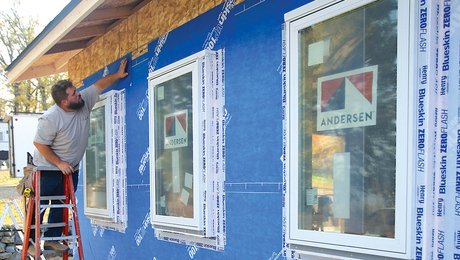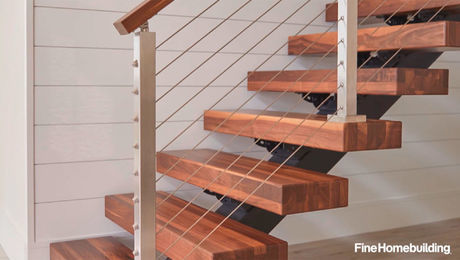I have 15 ga and 18 ga (2″), Would 18 be too thin for cherry crown modling on wall cabinets? I can get a16 ga if it’s perferable.
Should I use glue as well with nails??
Thank you

Getting the details right for a wall assembly with the control layers to the exterior and lots of drying potential.

"I have learned so much thanks to the searchable articles on the FHB website. I can confidently say that I expect to be a life-long subscriber." - M.K.
Get home building tips, offers, and expert advice in your inbox

Dig into cutting-edge approaches and decades of proven solutions with total access to our experts and tradespeople.
Start Free Trial Now
Get instant access to the latest developments in green building, research, and reports from the field.
Start Free Trial Now
Dig into cutting-edge approaches and decades of proven solutions with total access to our experts and tradespeople.
Start Free Trial NowGet instant access to the latest developments in green building, research, and reports from the field.
Start Free Trial Now© 2025 Active Interest Media. All rights reserved.
Fine Homebuilding receives a commission for items purchased through links on this site, including Amazon Associates and other affiliate advertising programs.
Get home building tips, offers, and expert advice in your inbox
Become a member and get instant access to thousands of videos, how-tos, tool reviews, and design features.
Start Your Free TrialGet complete site access to expert advice, how-to videos, Code Check, and more, plus the print magazine.
Already a member? Log in
We use cookies, pixels, script and other tracking technologies to analyze and improve our service, to improve and personalize content, and for advertising to you. We also share information about your use of our site with third-party social media, advertising and analytics partners. You can view our Privacy Policy here and our Terms of Use here.
Replies
I've seen an installer use a 23ga micropinner on prefinished crown. Couldn't even see the nail holes. He ripped a 2X4 in half for blocking above the cabinets and nailed to that.
Typically the smaller the fastener the better if it's well supported. Glue your joints so they'll stay closed and increase the strength of the works.
If you really want to go with as few nails as possible, a wood backer closely fitted to the crown can be attached first as described above and the crown is glued on with construction adhesive with only the bare minimum of 18 or 23g pins, and/or blue painters tape.
Typically an 18g by itself is plenty strong for crown. Keep brads in less visible areas (sunken portions of the profile, knots, easily filled areas) and perhaps even angle two pins into the same hole but going different directions if additional holding power is required.
Stay away from the portions of the profile that reflect light since these are the hardest to putty well.
If your cabinets go to the ceiling with the top of the crown in contact with the ceiling a clear paintable caulking can be carefully applied in the joint (essentially none visable on the stained crown) providing a great deal of support for the crown. It also allows any gaps to be painted the color of the ceiling eliminating the black lines that are so much more obvious.
Even though it's possible to sand the area under the crown, as well as the portion of crown that actually makes contact with the cabinet and use a wood glue for attachement, sanding finished cabinets is often a bad idea since it's not uncommon for things to be changed and sanding is so very unreversible.
Best of luck
Beer was created so carpenters wouldn't rule the world.
Thank you, Don.
installing crown is the most difficult task to me in my diy kitchen, all wall cabinets are up to ceiling in 2". I ordered wall cabinets with extra wide top rails to simplfy crown moldling, hope everything works out fine.
I also need to install light rails on the bottom of wall cabinets, use finish nails or screws? the installation I have seen, they all used dry wall screws.
Drill and countersink the screw holes in the light rail in a location that you will determine based on how far forward or back you wish to place it on the cabinet relative to the door and overlay face..
I use trim head screws, I still have to drill but I can eliminate having to countersink plus they are square drive.
You could nail it, but it's a bit risky as an errant nail will be sure to pop right through in the most obvious of spots.
And another vote for the 23ga pinner.
Bostich makes a decent one for around $100.00
Eric[email protected]
It's Never Too Late To Become What You Might Have Been
I'd say the choice between nails and screws is mostly dependant on the shape of the undercabinet molding. Some with a high spring angle make hiding screws difficult.
Keep in mind that under-cabinet molding is much more likely to get touched, banged, and whatnot, so it needs to be put on well or the corners will open up.
If at all possible I'd go with trim-head screws and brads, glueing all joints.
Beer was created so carpenters wouldn't rule the world.
double stick tape and a 23ga pinner...
Life is not a journey to the grave with the intention of arriving safely in a pretty and well preserved body, but rather to skid in broadside, thoroughly used up, totally worn out, and loudly proclaiming
WOW!!! What a Ride!
Forget the primal scream, just ROAR!!!
I have done 2 kitchens now with my porter Cable 23G pinner for crown and other small moldings for the cabinets.Works great. And yes on the gluing of joints and miters.
I also use an 18G for the under cabinet molding but typically use the pinner for the crown. you can barley even see the nail holes when you done.
if the crown is of good size I may be more inclined to use the 18G because they have a small head where as the 23G pinner nails have no heads . But if you gve good support to the back of the crown the 23G pinner can't be beat.
Best of luck.
Raymond
PS. I like the porter cable pinner the best!!! It has not let me down once yet.
Just my opinion
I usually cut all of the peices to fit first. Then glue the corners using that High-Pur hot melt glue with the 60 second cure time. Then I'll predrill and counter sink the holes through the top of the cabinets and use the screw buttons that come with the cabinets to cover the screw heads. Has worked well so far. Before I got the glue system, i used to pinn all the corners, but the less holes in the face of the trim the better.
My preference? 23 ga. brads....notice that's brads, not pins. The slight heads do make a difference. As others have posted, glue your corners. Ridgid and tight corners add significant strength to the assembly. If it's humongous crown, I may use 18 ga., but the more I use 23, the more I trust 'em. I have to remind myself that crown isn't structural, and it doesn't take much to keep it in place.
On open top cabinets, I sometimes run a bead of Power Grab where crown meets wall to stabilize the assembly. Also been known to run bead along crown to cabinet joint to eliminate light from overhead shining through any cracks...that's after install, mind you! And since we're on the subject of open top cabinets, here's another great idea I saw in client's home. People put things on top of the cabs...plates, plants, whatever, but they "sink" behind the crown. Seen all sorts of blocks and upside down bowls to jack stuff up near the apparent top of cabinet. Cut pieces of bead foam the appropiate thickness (usually 2-3"), flop it on top of cabs and viola!, a continuous "floor" on whole cabinet top. Makes placing things up there way easier.
Here's another trick I learned many moons ago. A marker or some stain similar to crown color swiped on the raw miters and/or copes before assembly will get away from "white lines". Do one with and one without to see the difference. The darker the crown, the more white lines show up and look crappy
Oh, and one other thing. Get some Molding Glue, I think made by Franklin. Goes on more like paste and stays where you put it...no drips...very cool.
PJ
Everything will be okay in the end. If it's not okay, it's not the end.
Good advice. Also wanted to 2nd the trim and moulding glue._______________________________________________________________
I used to have a handle on life, but it broke
thank you all, 1 1/2" finish screws for 3/4" lights rails that is.
Used GRK 2 1/2" finish screws and mounting screws, thy are fabulous. No screw head on the frame, and no pre-drill was needed for mounting, and torx screw head never slip.